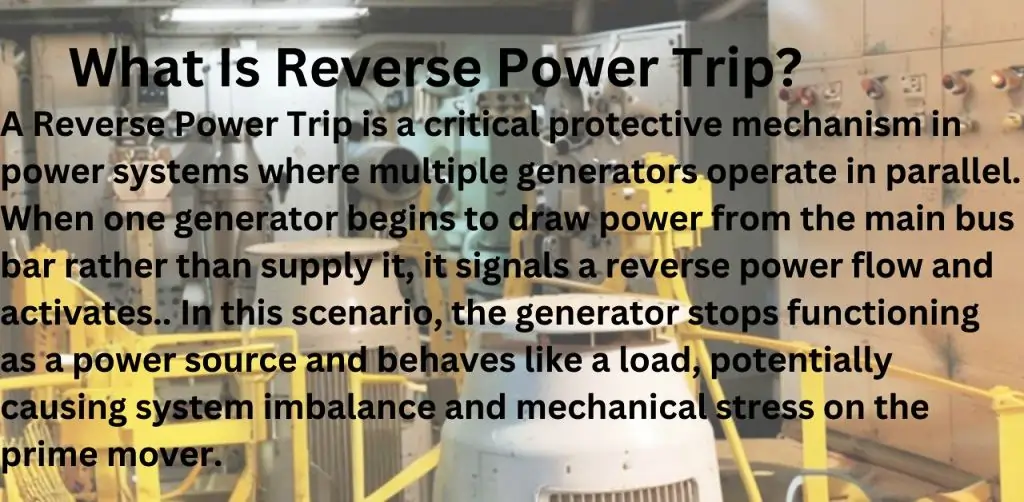What Is Reverse Power Trip?
A Reverse Power Trip is a critical protective mechanism in power systems where multiple generators operate in parallel. When one generator begins to draw power from the main bus bar rather than supply it, it signals a reverse power flow and activates.. In this scenario, the generator stops functioning as a power source and behaves like a load, potentially causing system imbalance and mechanical stress on the prime mover.
In this blog post, we will cover:
- How reverse power flow occurs and its impact on power systems.
- The components and working principle of a reverse power trip relay.
- Common causes of reverse power conditions and their potential risks.
- Best practices for maintaining system stability and preventing reverse power incidents.
Components and Working Principle of a Reverse Power Trip Relay
Key Components of a Reverse Power Trip Relay
A Reverse Power Trip Relay consists of several critical components that work together to detect reverse power flow and protect the system from damage. The main components include:
- Non-Magnetic Aluminum Disc:
The core element of the relay, this lightweight disc is placed between two laminated electromagnetic iron cores. It is designed to move in response to changes in the magnetic field caused by power flow variations. - Voltage Coil (PT):
This coil is wound around the upper electromagnetic core. It is connected to one phase of the generator’s output and an artificial neutral. The voltage coil has a higher inductive value due to its increased number of turns, which causes a delayed current lag of 90 degrees. - Current Coil (CT):
Connected to the same phase as the voltage coil, the current coil is wound on the lower electromagnetic core. It detects the current flowing through the system and generates a magnetic field proportional to the load. - Electromagnetic Iron Cores:
These soft laminated iron cores provide the necessary magnetic flux to detect the reverse power condition. They are carefully calibrated to respond to small variations in the power flow.
Working Principle of a Reverse Power Trip Relay
The relay operates based on the interaction between the voltage coil and the current coil. Under normal conditions, the magnetic field generated by the voltage and current coils is in sync, and the relay remains inactive. However, when reverse power flow occurs, the following happens:
- Magnetic Field Disruption:
Reverse power flow causes a shift in the magnetic fields of the coils, creating a difference between the induced currents in the voltage and current coils. - Induced Movement of the Aluminum Disc:
This magnetic disturbance causes the non-magnetic aluminum disc to move. The disc’s movement is proportional to the magnitude of the reverse power flow. - Relay Activation:
If the reverse power flow exceeds a set threshold, the movement of the disc triggers the relay mechanism, signaling the system to disconnect the generator from the bus bar.
Common Causes of Reverse Power Conditions and Their Potential Risks
Common Causes of Reverse Power Conditions
- Generator Synchronization Failures
One of the most common causes of reverse power flow occurs during the synchronization process. If a generator is not properly synchronized with the main bus or the grid, it may start drawing power instead of supplying it. Improper synchronization can occur during startup, shutdown, or when reconnecting generators to the grid. - Prime Mover Failure
The prime mover (such as a turbine, engine, or motor) is responsible for driving the generator. If the prime mover loses its power or fails to function correctly, the generator may begin to act like a motor, consuming power from the system rather than supplying it. Mechanical failures or loss of fuel or steam pressure can result in such failures. - Faulty Governor Control
The governor controls the speed and power output of the prime mover. A malfunction in the governor system can cause the generator to operate under-loaded or unstable, resulting in reverse power flow. This condition may happen if the governor fails to regulate the speed or output effectively. - Load Imbalance or Unintended Load Sharing
In systems with multiple generators, an improper load sharing between generators can lead to reverse power conditions. If one generator is asked to supply more power than it can handle, or if another generator fails to contribute adequately, the excess load may force the weaker generator to draw power from the grid. - Operator Error
Human error during switching operations or incorrect manual synchronization can trigger reverse power conditions. Mistakes such as incorrect phase sequence or failure to monitor generator load and output can cause the generator to start drawing power.
Potential Risks of Reverse Power Conditions
- Overloading of Other Generators
When one generator begins drawing power, it can overload the remaining generators in parallel. This imbalance leads to tripping of the generators and may cause cascading failures across the system. - System Instability and Blackout
Reverse power flow can destabilize the entire power system, leading to preferential tripping or a complete blackout. If the reverse power condition persists, the grid may fail to maintain proper voltage and frequency levels, resulting in a system-wide shutdown. - Mechanical Damage to the Generator
When a generator operates in reverse power mode, it can cause mechanical stress on its components. The motoring effect leads to increased RPM, which can cause over-speed trips and potentially catastrophic damage to the prime mover, including bearing failure or turbine blade damage. - Increased Operational Costs
Reverse power conditions can lead to significant financial losses. These include costs associated with generator repairs, system downtime, and energy losses from inefficient operation. - Reduced Lifespan of Equipment
Continuous exposure to reverse power conditions can degrade the quality and lifespan of the equipment. Over time, the increased mechanical stress and electrical imbalances can cause wear and tear on the generators, leading to higher maintenance and replacement costs.
Best Practices for Maintaining System Stability and Preventing Reverse Power Incidents
1. Proper Generator Synchronization
One of the most crucial steps in preventing reverse power conditions is ensuring proper synchronization of generators. Before connecting a generator to the grid or main bus bar, it’s essential to match the voltage, frequency, and phase of the generator with the system to avoid reverse power flow. Automated synchronization systems can assist operators in achieving precise alignment, reducing the risk of synchronization failures.
2. Regular Maintenance and Inspection of Prime Movers
Routine maintenance of prime movers (e.g., turbines, diesel engines, gas turbines) is vital to ensure they operate efficiently and can supply the required power. Regular checks for wear and tear, fuel quality, and proper functioning of mechanical components help prevent failures that could lead to reverse power situations. Additionally, performing preventive maintenance on control systems (e.g., governor and fuel regulators) ensures optimal performance.
3. Use of Advanced Monitoring and Control Systems
Implementing advanced monitoring and control systems allows operators to track real-time parameters, such as voltage, frequency, and load conditions, across all generators in the system. These systems can trigger alarms or automatic actions to adjust power flow and prevent reverse power conditions before they cause system instability.
4. Training and Operator Awareness
Proper training for operators is essential to minimize human errors in load-sharing and switching operations. Operators should be well-versed in the procedures for starting, stopping, and synchronizing generators, as well as handling emergency situations. Regular drills and refresher courses can enhance their ability to recognize and address potential reverse power flow conditions.
5. Load Management and Distribution
Effective load management ensures that power demand is evenly distributed among the generators, preventing overloading and underloading of any single unit. By utilizing load-sharing systems and automatic load control, it’s easier to prevent one generator from becoming a load, thus reducing the chances of reverse power incidents.
6. Installation of Reverse Power Trip Relays
Installing reverse power trip relays is one of the best practices for safeguarding the system. These relays automatically disconnect a generator from the grid or main bus bar if reverse power flow is detected, minimizing the risk of equipment damage, over-speed trips, or system failures. Proper calibration and regular testing of these relays are also essential for reliable operation.
By implementing these best practices, power system operators can effectively maintain system stability, prevent reverse power incidents, and ensure safe and reliable power generation and distribution.
FAQ: What Is Reverse Power Trip?
Q. What causes a reverse power trip?
Ans. A reverse power trip occurs when a generator starts drawing power from the main bus bar instead of supplying it, causing reverse power flow.
Q. What is reverse powering?
Ans. Reverse powering happens when electrical energy flows into a generator, instead of it generating power.
Q. How can you check for a reverse power trip?
Ans. You can check for reverse power trip by monitoring load shifts using the governor control system.
Q. Why is a reverse power relay used?
Ans. A reverse power relay is used to disconnect a generator that is no longer supplying power, preventing damage to the system.
Conclusion
A Reverse Power Trip is a crucial protection mechanism in power systems, preventing generators from running in reverse power mode and safeguarding the entire system from potential damage. By understanding how reverse power flow occurs and the role of reverse power relays, operators can ensure the stability and reliability of power generation systems. Implementing the right safeguards and maintenance practices is essential to avoid costly incidents and maintain optimal performance in 2025 and beyond.

